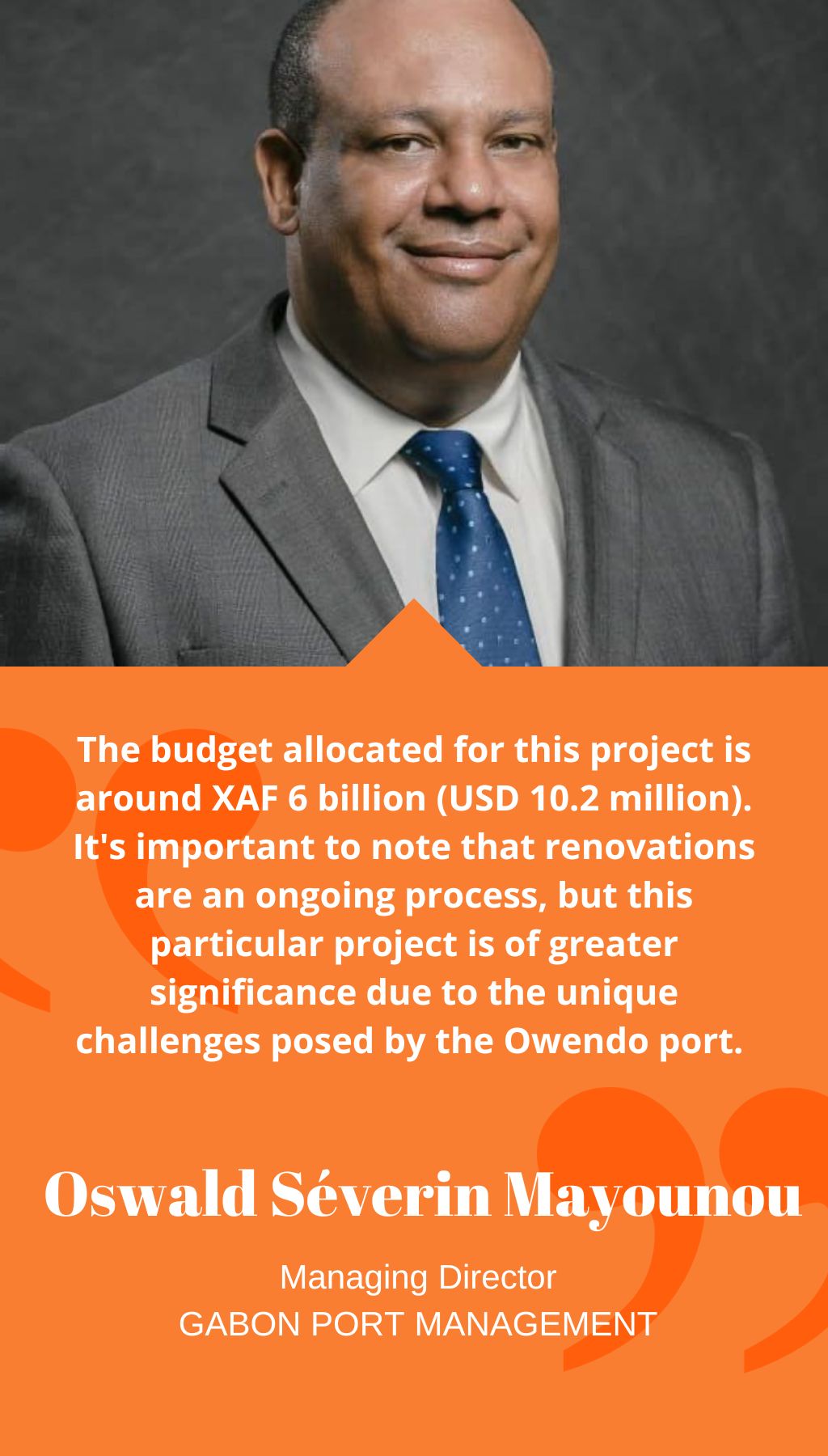
- Gabon | 16 July 2019

Could you provide an overview of the recent renovations carried out by Gabon Port Management in the port of Owendo?
Certainly. Apart from the installation of two Gottwald mobile cranes in 2012 and an additional one in 2014, the most significant renovation project at the Owendo Port involves the piles under the quays. This port was constructed back in 1974, and due to its fragility, we must renovate and repair the pontoon’s facade beneath the docks every six years. The project, undertaken by CGTE (Gabonese Company of Work and Study), commenced at the end of 2015 and is expected to last approximately four years.
Could you elaborate on these renovations and their significance?
Certainly. These renovation works are often referred to as “hidden works” because they are not apparent when visiting the port, as they primarily take place underwater. The budget allocated for this project is around XAF 6 billion (USD 10.2 million). It’s important to note that renovations are an ongoing process, but this particular project is of greater significance due to the unique challenges posed by the Owendo port. Unlike the Port-Gentil port, which is not built on piles and is situated in a different environment, Owendo’s location in an estuary necessitates extensive renovations.
How do you evaluate the economic viability of the three mobile cranes at Owendo?
The three mobile cranes at Owendo Port are rented out to operators such as STCG (Container Terminals Firm of Gabon). Furthermore, we outsource the maintenance and provision of the cranes to local operators. The arrival of these cranes has revolutionized the port’s operations, significantly improving waiting and unloading times. A mobile crane can unload a ship in just two days, compared to approximately one week with a deck crane. However, we are currently facing logistical difficulties as our clients prefer using their own deck cranes, even though it takes longer to unload. This preference stems from the lack of storage areas outside of the Customs area and the absence of efficient logistical routing plans from the Customs area to their base. As a result, operators are reluctant to use our mobile cranes, which leads to longer waiting times and potentially hinders the port’s perceived efficiency.
What challenges does this situation pose for Gabon Port Management?
The use of deck cranes for unloading cargo, such as cement, can extend the process to eight days. During this time, the space remains occupied, preventing other ships from entering the port. As long as operators continue to prefer their own deck cranes, we will face longer waiting times, which may create the impression that the port is inefficient. However, the actual problem lies in the clients’ reluctance to use our mobile cranes due to concerns about the lack of logistical support and storage facilities. This situation may lead to a congested harbor with excessive equipment occupying the port, as clients struggle to rapidly evacuate their merchandise to its intended destination.
Are there any plans to invest in mobile cranes for the port in Port-Gentil?
Currently, the port in Port-Gentil relies solely on deck cranes. However, we are committed to conducting a study to assess the feasibility and potential impact of introducing mobile cranes in Port-Gentil. This study takes into account the challenges and experiences encountered with mobile cranes in the Owendo port. It is an important consideration as we have observed a demand for mobile cranes from both our operators and clients.
How could the Port-Gentil port function more effectively?
In Port-Gentil, the main focus is not on waiting time or congestion, as the port operates in deep waters, allowing for fluid traffic. However, the issue lies in the organization and management of space. Gabon Port Management, along with OPRAG (l’Office des Ports et Rades du Gabon) and STCG, is working on a proposal to build a mini container terminal in Port-Gentil. The aim is to centralize all containers in one location, similar to the setup in Libreville. This consolidation would facilitate the efficient removal of incoming merchandise and enhance the port’s overall effectiveness.
What innovative techniques are being considered for the ports of Port-Gentil and Owendo?
As the world evolves, we recognize the need to adapt to new trends. Gabon Port Management has already established a hydrography service, making us one of the few entities in Gabon capable of providing fully equipped bathymetric surveys along the entire 800-km coast. We are currently conducting feasibility studies for the port of Mayumba, which is under construction. Additionally, we offer an AIS (Automatic Identification System) service in Owendo, allowing us to track ships entering Gabonese waters and heading towards the Owendo port. This system provides detailed information about the ships, including their location, speed, direction, size, cargo type, and more.
How are you addressing the need to increase the estuary’s depth to accommodate larger vessels at the Owendo port?
Unlike the deepwater port in Port-Gentil, the Owendo port is situated in an estuary, which means we face silt accumulation whenever a ship enters or leaves. Dredging the entire Owendo port has become one of our most significant tasks and expenses. We have a contract with Boskalis, a company responsible for dredging works on a monthly basis to maintain adequate water depths. With the increasing number of deep-draught vessels arriving at our port, dredging is essential to allow larger ships to enter. However, we require approximately four days every two months to dredge around 40,000 cubic meters. Consequently, ships may experience waiting times, and if our bathymetric survey indicates insufficient depth, we are obligated to conduct dredging operations to ensure safe passage.














